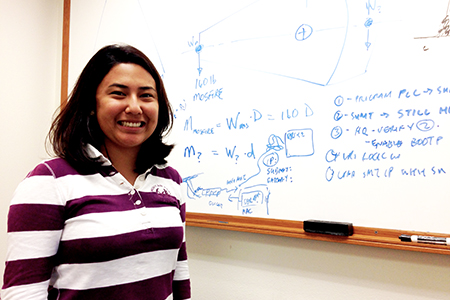
Brialyn Onodera was born and raised on the Big Island of Hawaii. A graduate of Kamehameha Schools, she attended the University of Hawaii at Hilo for three years, then transferred to the University of Hawaii at Manoa in the fall of 2014. She is currently enrolled there, studying Mathematics and Mechanical Engineering. She intends to graduate with her bachelor’s degree in both majors and plans to get her master’s degree in Mechanical Engineering. After growing up in Hawaii, where she gained a fascination for the ocean and the life it harbors, she would like to find a job building robots to be used for underwater research.
Home Island: Hawaii Island
High School: Kamehameha Schools Hawaii
Institution when accepted: University of Hawaii at Manoa
Project Site: W.M. Keck Observatory
Mentor: Truman Wold
The twin W.M. Keck Observatory telescopes are currently balanced by manually bolting steel plates to the telescopes. This method is time consuming and unsafe, prompting the need for a more efficient balancing system. Initial research was conducted on the balancing systems for Keck and other observatories to determine requirements of an improved system. Evaluating current balancing operations on the Keck telescopes led to three different scopes of weight adjustments: “fine-tuning” involves small weight changes to correct minor imbalances; “reconfiguration” addresses weight changes caused by instrument exchanges; “total telescope balancing” includes fine-tuning and reconfiguration but also fixed weight changes to counteract more permanent telescope fixtures. To address these scopes simultaneously, three feasible designs were conceptualized which include improving the current system, moving weight, and fluid transfer. Improving the current system could involve a mechanized method of moving and attaching weight. Moving weight and fluid transfer are both dynamic methods that controllably move metal plates or liquid, respectively, for rebalancing. Evaluating different design concepts demonstrated that a combination of moving weight and fluid transfer is recommended to address all three weight scopes. Small dynamic moving weights in both solid and fluid form would easily address the “fine-tuning” scope, while a slightly larger version would address the “reconfiguration” scope. The “total telescope balancing” scope would require the largest dynamic weight changes, but would still incorporate the use of static weights. Using these recommendations, Keck will be able to design a system that addresses the balancing needs of the telescope more efficiently and can support heavier instruments and weight changes in the future.